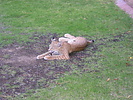Introduction
Students at Catalina Foothills High School in Tuscon, AZ created these treehouses as part of a three-part ecosystems unit called: Studying Sonoran Desert Organisms in Freshman (High School) Honors Biology. In this unit students focused on general ecosystem information acquired from reading and class activities, and the specific ecosystem information they learned in groups about the local ecosystem – the Sonoran desert in which Tucson is located. For part of this unit students could choose to do an independent study that involved:
- Creating a photo essay about their favorite local (natural) place
- Doing volunteer work to further the local ecosystem (such as pulling invasive buffelgrass or working for a few hours at a recycling center
- Constructing a ToL treehouse about a local species (native or introduced)
These treehouses represent the work of students who chose to do an independent study and publish it as a treehouse.
Coming soon...a link to the Teacher Resource Treehouse: Studying Sonoran Desert Organisms. This treehouse will explain how to do the entire unit.
Portfolio Pages
- Badgers of the Sonoran Desert
-

- The badger can be found all over the Western United States, in Southwestern Canada and in Northwestern Mexico. It is often found in the southern part of the Sonoran Desert. The badger lives everywhere, but mostly near river beds where there is soft soil they can dig in. The badger likes to dig holes where it lives. The holes are often 20-30 cm wide and often have a pile of dirt around the opening. Inside the holes there are several corridors.
- Buffelgrass, An Invasive Species
-
 © 2005 aurelius1
© 2005 aurelius1
- Buffel grass is an invasive species that is hurting our beautiful Sonoran Desert. An invasive species is one that is non-native to the area it inhabits and uses up resources that are necessary for native species to survive. Buffel grass has several charcteristics that lead to it being not only a nuisance, but also a danger to our desert environment. We need to eliminate it in our beautiful desert country before it leads to the destruction of many of our important native plants.
- Buffelgrass Investigation
-
 © maximus1
© maximus1
- When I was pondering what to research for this treehouse, I decided that I wanted to look into an invasive species. Our science class created a 3-D map of Pima County and on it were two prominent invasive species, one being buffelgrass, and the other, bullfrogs. This sparked my interest in invasive species, and when I heard of an optional buffelgrass pull that was going to take place in Sabino Canyon, I instantly signed up. During the pull and during my research I learned about the the impact that buffelgrass has on the environment, and once I felt I had done something to help the problem, I thought it necessary to go into more depth and create this page.
- Desert Tortoises and the Environment
-
©
- The desert tortoise has many unique characteristics. These include its ability to burrow into the ground to escape the summer heat. Most of these characteristics, both physical and behavioral, were developed to help them in their environment. They are interesting because most of their life is spent underground; they are only on the surface about five percent of their unusually long lives. All these characteristics, strange as some may seem, all serve a very important purpose; they all allow the tortoise to survive in the Sonoran Desert.
- Prairie Falcons in the Sonoran Desert
-
 © 2005 Marta Hernandez, Arizona-Sonora Desert Museum, Tucson, AZ
© 2005 Marta Hernandez, Arizona-Sonora Desert Museum, Tucson, AZ
- The Prairie Falcon is a cold-hardy and heat-tolerant raptor that can usually be found near dry places. This website will talk about how the Prairie Falcon survives in harsh conditions like those found in the Sonoran Desert.
- Where Bobcats Live
-
 © 2005 butterfly1
© 2005 butterfly1
- Bobcats are nocturnal and like to be secluded from humans. This is getting harder for them because humans are destroying their habitat. Bobcats are very timid and like to avoid human contact. However, with humans destroying their habitat, contact between bobcats and humans is becoming more frequent. This treehouse contains images of bobcats lounging in the author's backyard!
Information on the Internet
- Sonoran Desert Conservation Plan: Species in Pima County A number of students who constructed treehouse pages chose their species of interest from this website.


 Go to quick links
Go to quick search
Go to navigation for this section of the ToL site
Go to detailed links for the ToL site
Go to quick links
Go to quick search
Go to navigation for this section of the ToL site
Go to detailed links for the ToL site